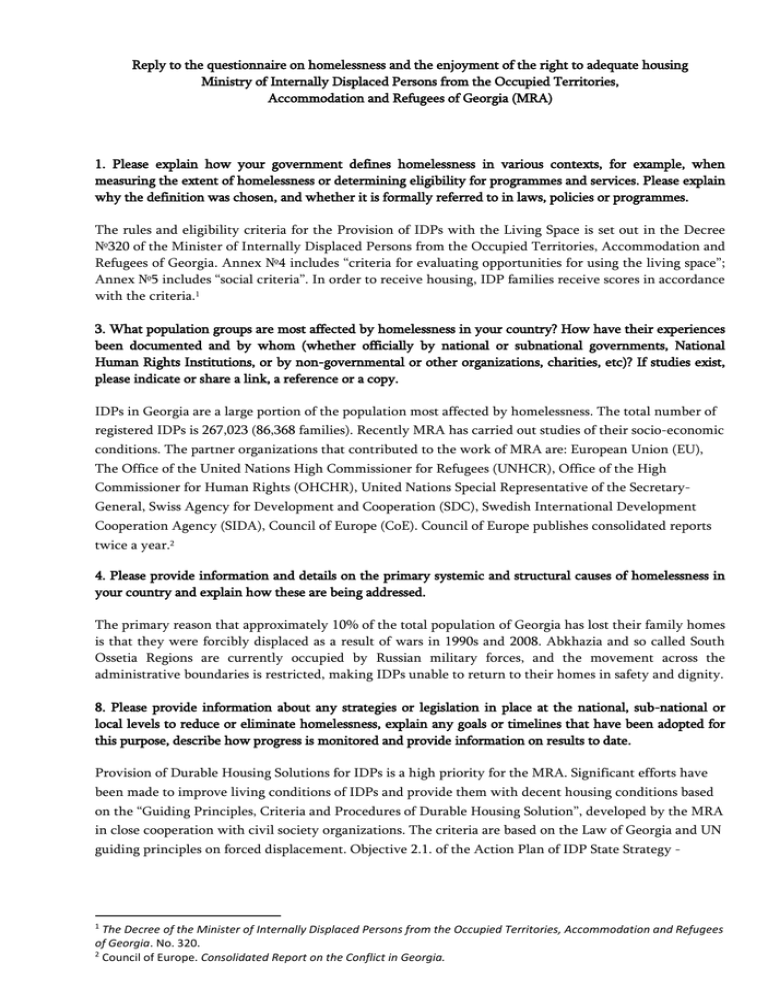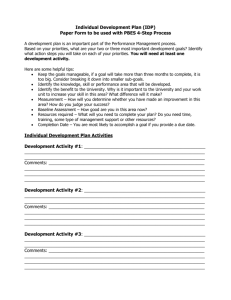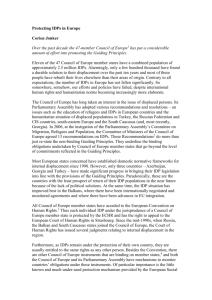Reply to the questionnaire on homelessness and the enjoyment of... Ministry of Internally Displaced Persons from the Occupied Territories,
advertisement

Reply to the questionnaire on homelessness and the enjoyment of the right to adequate housing Ministry of Internally Displaced Persons from the Occupied Territories, Accommodation and Refugees of Georgia (MRA) 1. Please explain how your government defines homelessness in various contexts, for example, when measuring the extent of homelessness or determining eligibility for programmes and services. Please explain why the definition was chosen, and whether it is formally referred to in laws, policies or programmes. The rules and eligibility criteria for the Provision of IDPs with the Living Space is set out in the Decree №320 of the Minister of Internally Displaced Persons from the Occupied Territories, Accommodation and Refugees of Georgia. Annex №4 includes “criteria for evaluating opportunities for using the living space”; Annex №5 includes “social criteria”. In order to receive housing, IDP families receive scores in accordance with the criteria.1 3. What population groups are most affected by homelessness in your country? How have their experiences been documented and by whom (whether officially by national or subnational governments, National Human Rights Institutions, or by non-governmental or other organizations, charities, etc)? If studies exist, please indicate or share a link, a reference or a copy. IDPs in Georgia are a large portion of the population most affected by homelessness. The total number of registered IDPs is 267,023 (86,368 families). Recently MRA has carried out studies of their socio-economic conditions. The partner organizations that contributed to the work of MRA are: European Union (EU), The Office of the United Nations High Commissioner for Refugees (UNHCR), Office of the High Commissioner for Human Rights (OHCHR), United Nations Special Representative of the SecretaryGeneral, Swiss Agency for Development and Cooperation (SDC), Swedish International Development Cooperation Agency (SIDA), Council of Europe (CoE). Council of Europe publishes consolidated reports twice a year.2 4. Please provide information and details on the primary systemic and structural causes of homelessness in your country and explain how these are being addressed. The primary reason that approximately 10% of the total population of Georgia has lost their family homes is that they were forcibly displaced as a result of wars in 1990s and 2008. Abkhazia and so called South Ossetia Regions are currently occupied by Russian military forces, and the movement across the administrative boundaries is restricted, making IDPs unable to return to their homes in safety and dignity. 8. Please provide information about any strategies or legislation in place at the national, sub-national or local levels to reduce or eliminate homelessness, explain any goals or timelines that have been adopted for this purpose, describe how progress is monitored and provide information on results to date. Provision of Durable Housing Solutions for IDPs is a high priority for the MRA. Significant efforts have been made to improve living conditions of IDPs and provide them with decent housing conditions based on the “Guiding Principles, Criteria and Procedures of Durable Housing Solution”, developed by the MRA in close cooperation with civil society organizations. The criteria are based on the Law of Georgia and UN guiding principles on forced displacement. Objective 2.1. of the Action Plan of IDP State Strategy - 1 The Decree of the Minister of Internally Displaced Persons from the Occupied Territories, Accommodation and Refugees of Georgia. No. 320. 2 Council of Europe. Consolidated Report on the Conflict in Georgia. “Improving the living conditions of the IDPs by ensuring the alternative durable housing solutions” includes goals and timelines.3 The MRA has launched multiple accommodation programs for IDPs: In 2014, the MRA purchased 8 apartment blocks from the Chinese company “Hualing International Special Economic Zone”. According to the agreement, 330 apartments are to be delivered in autumn of 2015, while additional 300 will be completed in February and June, 2016. Negotiations are underway on purchasing of additional living space in existing complex, as well as in those to be constructed. Within the framework of the RE developers program launched in December 2014, the MRA has purchased 603 housing units from the Georgian RE developers and construction companies. The process of signing agreements with Re developers and construction companies is ongoing. The MRA has started the construction of the hi-rise apartment blocks for IDP families in Imereti and Samegrelo regions. 2 blocks in Kutaisi, Imereti region will provide housing for 160 IDP families, and 2 blocks in Zugdidi, Samegrelo region - for 144 families. The construction works will be completed in 2016. In Gori construction of 480 housing units will be completed by 2017. The “Rural Housing Solutions” (RHS) program envisages providing DHS to IDP families. The MRA has processed 1,423 IDP applications for the rural housing program, out of which 672 applications were approved. 372 IDP families have been provided with DHS in rural areas. More IDP families will receive housing in rural areas, as the process is ongoing. The Rehabilitation program for 2015 will provide 542 rehabilitated flats in different regions of Georgia for the IDP families by the end of the year; Reconstruction works for 2016 are planned for 393 apartments. The Privatization program envisages transferring housing units to IDP families into private ownership. Under the program, 8,000 – 10,000 target groups will be inspected. The program started in November 2014 and is ongoing. As of now, the Georgian government issued an order on provision of DHS for 6,122 IDP families and out of those, 2,515 IDP families have already acquired private ownership; In addition, 1,821 IDP families had received private ownership in 2014 outside of the program. The privatization process is highly dynamic and the numbers are constantly updated. The MRA has set up a pilot project - "Mortgage Loan Repayment for the IDPs". Loan repayment of max. 20 000 GEL was offered to the IDP families, who have purchased their accommodation with the mortgage loan until January 1st, 2015. A total of 410 applications had been received and 50 were approved. The MRA has started a project to provide IDPs with individual housing units (new cottage type settlements) in association with Swiss Agency for Development and Cooperation (SDC) and Danish Refugee Council (DRC). As of now, 14 IDP families have been selected for the project, which will be completed in 2015. 3 Overall Assessment of the Resources Required for the Implementation of the Action Plan of IDP State Strategy.


